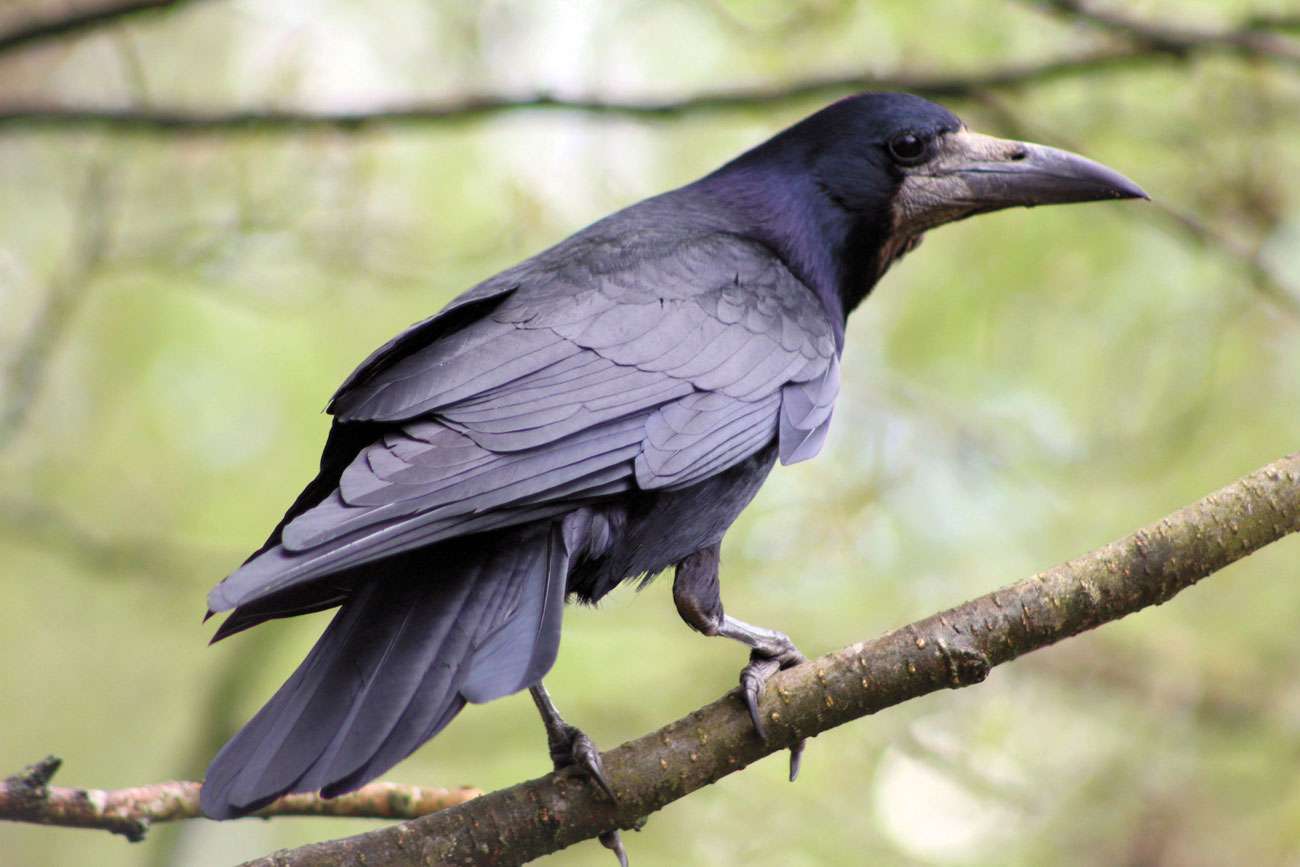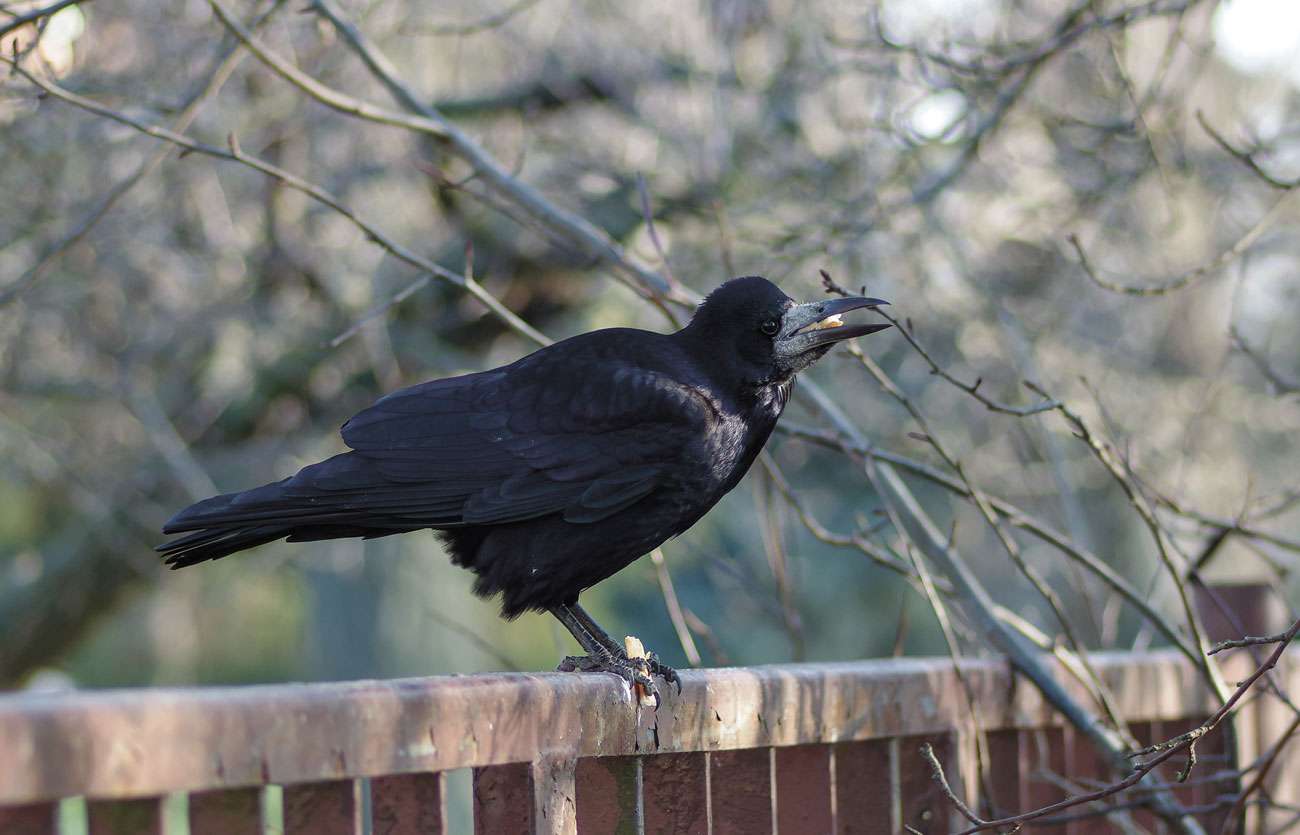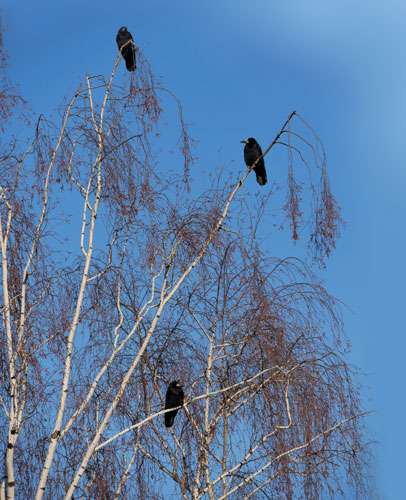
Slightly smaller than the Crow, the adult Rook (Corvus frugilegus) has a pointed grey bill with pale skin extending to the eye, ‘baggy trousers,’ peaked crown and a more wedge-shaped tail
Litter louts! What a load of rubbish there was lying around as I passed by the playground at Cranleigh’s Snoxhall Fields the other day.
But don’t blame the kids. Or the parents. The offenders are Rooks and they are smart enough to know where they can get a free meal.
Carefully binned leftovers from picnics and takeaways are a target. And they show little fear of us humans as they strut around the play area to rescue a tasty snack from the deposited trash.
During the winter I have been seeing large flocks of over 100 noisy Rooks as they grub around excitedly for healthier fare such as invertebrates on the fields around the village.
Invariably feeding with Jackdaws, their smaller Crow family cousins, their dark shapes show up well against a green background. They were better camouflaged back in the days when more of our winter fields were brown earth or stubble.
But they were always betrayed by their raucous calls which carry for a good half a mile. In the fields towards dusk the Rooks mark their departure with what Ian Francis, of Alford in Aberdeenshire, has described as all hell breaking loose:
‘They rise in one great mass and circle above the wood. It’s like one of those childhood snowstorms, only in black, or like being in a planetarium where someone has speeded up the stars. The sky is filled with thousands…calling excitedly and undertaking the most amazing aerobatics, pirouettes and loops.’

Rook (Corvus frugilegus). Always on the lookout for a bit of food
Then their somewhat ragged outlines head back purposefully away from the confusion to their rookeries. I call their colour ‘dark’ although many would describe them as black.
But get close to a Rook, while it is raiding the local playground and high street bins before most people have emerged for the day, and you might be surprised by their subtle beauty.
They have a glossy sheen and, depending on the sunlight and angle they are viewed, their feathers can display hues of blue and bronze with trickles of red.
Their repeated calls, ‘kaahh, kaahh, kaahh,’ are the traditional background music – some would say cacophony – in rural areas like ours.
If I think of the word ‘village’ it conjures up visions of an old English oil painting featuring noisy whirling Rooks, an ancient church and a welcoming pub.
The Rooks are among the first to nest in Spring and for the last few weeks they have been busy building new and repairing old homes at their communal rookeries, most obviously around our parish church of St Nicolas.
They have been often seen since last Autumn when they began this season’s courtship display. It is as if they fear they will lose their chosen position in the rookery if they wander too far.
With the approach of March I witnessed appalling behaviour between neighbours. It is something that can happen when homes are placed too close. Arguments and squabbles have been rife over the ownership of building materials and boundary intrusion.
A lot of the birds think there is no point wasting energy collecting their own sticks when they can nick them from a neighbour when he has gone off for a meal.
Soon we will be seeing the heads of the females poking up from their nests as egg laying begins in the leafless crowns of oaks and other tall trees. For the next few weeks the mums-to-be will be sitting tight at home while their dutiful partners hunt for the pair’s food.
Unlike smaller birds the chances are that many of the local Rooks you see today are ones you have noticed in previous years. They can live for around two decades and are quite faithful to the areas where they hatched. One ringed in Ewhurst, for instance, survived for over 14 years before being found dead in nearby Ockley.
It is hard to imagine a countryside without these fascinating birds. They have left their legacy in old English sayings and in our place names.
Their flight is direct so it is reckoned ‘as the crow flies’ was coined due to misidentified observations of Rooks, rather than the similar Crows.
What a pity the christeners of Crawley knew their birds so well. It might otherwise have been named Rookley – and we would never have had to forfeit our old name of Cranley to prevent confusion at the Post Office.
Twitter – @Crane_Spotter
Click here to see all of Robin Stride’s previous Crane Spotters.












